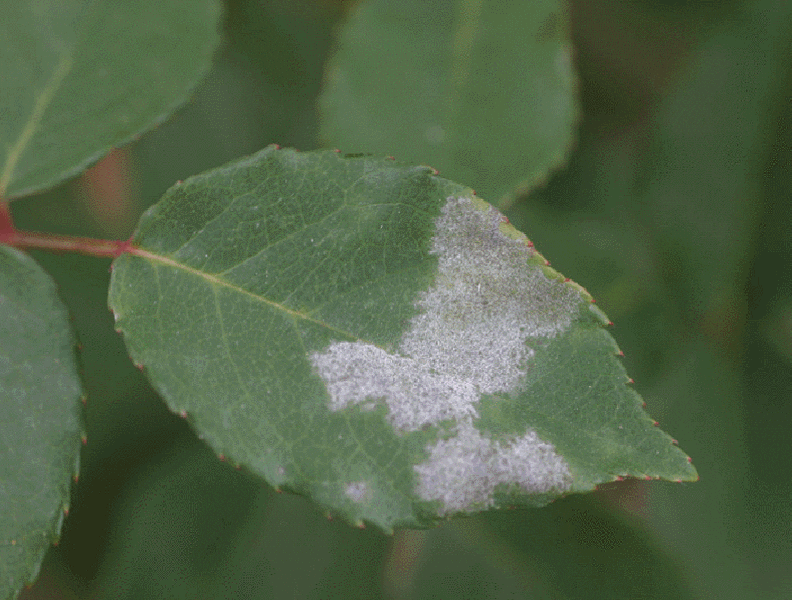
Powdery Mildew
Podosphaera Pannosa
Pathogène :
Fungus
Type:
Risque:
INTERMEDIATE
Oídio


QUI EN EST LA CAUSE ?
Powdery mildew, also known as white ash, is a fungal disease caused by various fungi of the genus Erysiphales. This pathogen affects a wide variety of plants, including roses, and manifests itself as a white or grayish powder that covers the leaves, stems, and sometimes even the flowers and fruits of the infected plant.
SYMPTÔMES
In rose bushes, powdery mildew can cause serious damage if not properly controlled. Symptoms include powdery white Taches on leaves and shoots, which can spread and merge over time, forming a dense layer that hinders photosynthesis and weakens the plant. Additionally, the growth and development of flowers and fruits may be negatively affected, resulting in decreased quality and quantity of production.

TEMPÉRATURE ET HUMIDITÉ
18°C - 25°C
60% - 80%
VOIES DE TRANSMISSION
Wind, direct contact between infected and healthy plants, as well as passive transport through gardening tools, hands or other contaminated objects.
Do you want to remove this pest? Choose how you want to treat it.
TRAITEMENTS
Traitements chimiques
• ORANGE OIL 6% [SL] P/V
• ORANGE OIL 60g/L [ME] P/S
• SULFUR 20% [SC] P/V
• SULFUR 70% [SC] P/V
• SULFUR 72% [SC] P/V
• SULFUR 80% [DP] P/P
• SULFUR 80% [SC] P/V
• SULFUR 80% [WG] P/P
• SULFUR 80% [WP] P/P
• SULFUR 82.5% [SC] P/V
• BUPIRIMATE 25% [EC] P/V
• COS-OGA 1.25% [SL] P/V
• DIFENOCONAZOLE 25% [EC] P/V
• POTASSIUM HYDROGEN CARBONATE 0.425% [AL] P/V
• POTASSIUM HYDROGEN CARBONATE 85% [SP] P/P
• PIRACLOSTROBIN 6.7% + BOSCALIDE 26.7% ( ) [WG] P/P
• TEBUCONAZOLE 0.0125% + TRIFLOXISTROBIN 0.0125% [AL] P/V
Traitements autorisés en agriculture biologique
• ORANGE OIL 6% [SL] P/V
• ORANGE OIL 60g/L [ME] P/S
• SULFUR 20% [SC] P/V
• SULFUR 70% [SC] P/V
• SULFUR 72% [SC] P/V
• SULFUR 80% [DP] P/P
• SULFUR 80% [SC] P/V
• SULFUR 80% [WG] P/P
• SULFUR 80% [WP] P/P
• SULFUR 82.5% [SC] P/V
• COS-OGA 1.25% [SL] P/V
• POTASSIUM HYDROGEN CARBONATE 0.425% [AL] P/V
• POTASSIUM HYDROGEN CARBONATE 85% [SP] P/P
Traitements biologiques
• AMPELOMICES QUISQUALIS 58% [WG] P/P
• BACILLUS SUBTILIS (STRAIN QST 713) 1.34% [SC] P/V
Recommandations
To prevent the appearance and spread of powdery mildew in rose bushes, it is important to follow appropriate cultural management practices, such as planting resistant varieties, maintaining adequate ventilation around the plants, avoiding overcrowding and excessive humidity, and performing appropriate pruning to promote good air circulation. Chemical control may also be necessary in severe cases, using specific fungicides for powdery mildew and applying them according to the manufacturer's recommendations.
Enlace patrocinado
Enlace patrocinado
Enlace patrocinado
Enlace patrocinado
Enlace patrocinado
Enlace patrocinado
Effective against all types of fungi
TRAITEMENTS
Remèdes maison
There are no home treatments
Alliés naturels
Traitements chimiques
There are no treatments for this disease. Treatments are directed at the insect vectors that transmit it. See insect treatments.
RECOMMANDATIONS
- Check the back of the leaves frequently, especially in dry weather.
- Spray water on the leaves to increase humidity and prevent them from settling.
- Keep plants healthy with good watering and adequate light.
- If you see cobwebs or damage, clean the leaves with a damp cloth or pressurized water.
- Use potassium soap or neem oil every few days until they disappear.
Plantes répulsives
Rosemary, Dill, Coriander
PRODUITS RECOMMANDÉS
Enlace patrocinado
Enlace patrocinado
Enlace patrocinado
Enlace patrocinado
Enlace patrocinado
Enlace patrocinado
Effective against all types of fungi
*Les traitements recommandés sont des recommandations basées sur les bases de données des autorités et ne remplacent en aucun cas les lignes directrices établies par la législation de chaque pays.
*Les produits présentés sont des recommandations et ne sont pas nos propres produits. En tant qu'associés Amazon, nous gagnons des revenus grâce aux achats de produits recommandés.






















